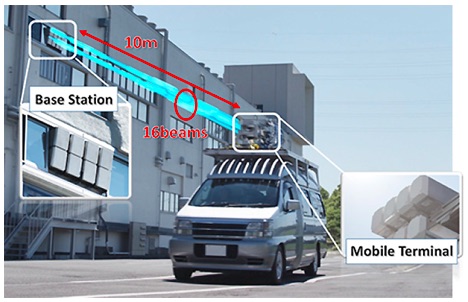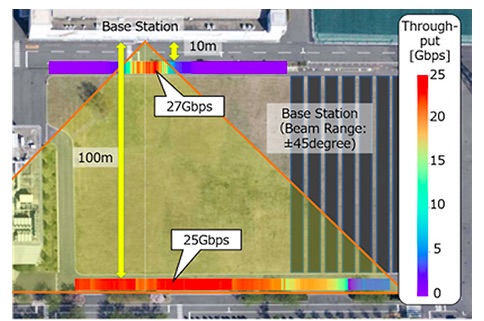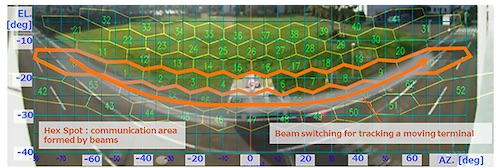|
Mitsubishi Electric and NTT DOCOMO Achieve World's First 27Gbps Throughput in 5G Outdoor Trials
World's first 5G transmission to mobile terminal exceeding peak data rate of 20Gbps
TOKYO, Nov 23, 2018 - (JCN Newswire) - Mitsubishi Electric Corporation (TOKYO: 6503) and NTT DOCOMO, INC. (TOKYO: 9437) announced today that they have achieved what they believe to be the world's first (as of today) fifth-generation (5G) mobile telecommunications proof of concept for 27Gbps and 25Gbps maximum throughputs via one mobile terminal over communication distances of 10m and 100m, respectively, using the 28GHz radio frequency. The demonstration was conducted during joint outdoor field trials using 28GHz-band massive-element antenna systems and 16-beam spatial-multiplexing technology with 500MHz bandwidth. The trial took place in Kamakura, Kanagawa Prefecture Japan from September 10 to 28, 2018.
 | | Outdoor trial (10 meters between base station and mobile terminal) |
 | | Overview |
 | | Figure 1: Outdoor trial site and throughput results according to position of mobile terminal |
 | | Figure 2: Tracking mobile terminal by beam switching (viewed from base station) |
http://www.acnnewswire.com/topimg/Low_NTTOutdoorTrial%20.jpg
Outdoor trial (10 meters between base station and mobile terminal)
Key Features
For outdoor trials using the 28GHz band, Mitsubishi Electric used an antenna system with 16-beam spatial-multiplexing technology(1). Base-station antennas installed on the wall of a building directed beams to mobile-terminal antennas installed on the rooftop of a vehicle.
The trial was the world's first successful wireless downlink transmission at maximum data rates of 27Gbps and 25Gbps for per one mobile terminal when the communication distance was 10m and 100m, respectively.
Overview
http://www.acnnewswire.com/topimg/Low_MitsubishiElectricNTTDOCOMOOverview%20.jpg
Future work
Indoor trials using 28GHz band in multipath-rich environments during fiscal year ending March 31, 2019.
Background
A peak data rate of 20Gbps is required for 5G mobile communications. One technology that promise to meet this need is massive-element antenna systems technology, which enables multi-beam spatial multiplexing where multiple data streams can be transmitted in parallel to mobile terminals. Realizing this technology, however, has involved two challenges: implementation of a massive-element antenna array that clusters large numbers of antenna elements for high-precision beamforming, and mitigation of inter-beam interference.
Mitsubishi Electric and DOCOMO have jointly undertaken "The research and development project for realization of the fifth-generation mobile communications system - High data rate and low-power-consumption radio access technologies with higher-frequency-band and wider-bandwidth massive MIMO" commissioned by Japan's Ministry of Internal Affairs and Communications. The focus of their research has been wideband massive MIMO and beam-control technologies for high SHF bands. To realize 20Gbps throughput using 500MHz bandwidth, they have now collaboratively developed and validated a massive-element antenna system enabling 16-beam spatial multiplexing.
Using 4G systems, it has not been possible to establish high data-rate communication for a single mobile terminal using more than four streams. Mitsubishi Electric and DOCOMO carried out 28GHz-band outdoor field trials to verify the feasibility of 16-beam spatial multiplexing in line-of-sight conditions(4), where massive-element base-station antennas installed on the wall of a building directed beams to mobile-terminal antennas installed on the rooftop of a vehicle. The mobile terminal moved along two different streets. The distance of one mobile terminal was 10m from the base station and the distance for the other was 100m (Fig. 1).
This news release includes a part of "The research and development project for realization of the fifth generation mobile communications system" commissioned by Japan's Ministry of Internal Affairs and Communications.
Details
Conventional 4G spatial multiplexing technology has limited multiplexing order, so Mitsubishi Electric and DOCOMO developed beamforming technology in an analog domain and inter-beam interference reduction technology to suitably separate overlapping beams with digital signal processing at the base station. The result is 16-beam spatial multiplexing, which has been unachievable with 4G.
The developed beamforming technology enables beams to track a mobile terminal by switching the preset beam (Fig. 2). The inter-beam interference reduction technology estimates the channel at the base station and controls the transmitting signal to adaptively reduce inter-beam interference as channel conditions over time. Together, the two technologies enable 16-beam spatial multiplexing in outdoor mobile environments.
The trials achieved the world's first successful wireless downlink transmissions at data rates of 27Gbps and 25Gbps when the distance between the base station and the mobile terminal was 10m and 100m, respectively. The achieved peak data rates correspond to spectral efficiency of 67bps/Hz5, believed to be the world's best performance for 28GHz-band mobile telecommunication.
The test achieved the goal of the Japanese government's research and development project to help realize 5G mobile communications based on high data-rate and low-power-consumption radio-access technologies and using an ultra-high-frequency band and extra-wide-bandwidth massive MIMO. The developed technologies are expected to enable wireless communications at ultra-high data rates of more than 20Gbps to moving vehicles with numerous passengers, such as buses.
http://www.acnnewswire.com/topimg/Low_MitsubishiElectricNTTDOCOMOFig1.jpg
Figure 1: Outdoor trial site and throughput results according to position of mobile terminal
http://www.acnnewswire.com/topimg/Low_MitsubishiElectricNTTDOCOMOFigure2.jpg
Figure 2: Tracking mobile terminal by beam switching (viewed from base station)
(1) Mitsubishi Electric announced on February 14, 2018 that it had developed 16-beam spatial-multiplexing technology consisting of eight analog, front-end processing, low-power units to form 16 beams and a multiple-input multiple-output (MIMO) digital processing algorithm to reduce inter-beam interference. New windowhttp://www.mitsubishielectric.co.jp/news/2018/0214-e.html (in Japanese only)
(2) Multiple-Input Multiple-Output
(3) Fastest 4G mobile communication system in Japan as of November 2018
(4) There was no obstacle between the base station and device. The environment for parallel transmission was challenging.
(5) Downlink occupancy is 80% of TDD frame, i.e. downlink : uplink = 4 :1
About Mitsubishi Electric Corporation
With nearly 100 years of experience in providing reliable, high-quality products, Mitsubishi Electric Corporation (TOKYO: 6503) is a recognized world leader in the manufacture, marketing and sales of electrical and electronic equipment used in information processing and communications, space development and satellite communications, consumer electronics, industrial technology, energy, transportation and building equipment. Embracing the spirit of its corporate statement, Changes for the Better, and its environmental statement, Eco Changes, Mitsubishi Electric endeavors to be a global, leading green company, enriching society with technology. The company recorded consolidated group sales of 4,444.4 billion yen (in accordance with IFRS; US$ 41.9 billion*) in the fiscal year ended March 31, 2018. For more information visit: https://www.mitsubishielectric.com/en/
*At an exchange rate of 106 yen to the US dollar, the rate given by the Tokyo Foreign Exchange Market on March 31, 2018
Contact:NTT DOCOMO
International PR
Public Relations Department
Tel: +81-3-5156-1366
Fax: +81-3-5501-3408
URL: www.nttdocomo.com
Contact: https://nes.nttdocomo.co.jp/PINQ01/showinquiry.do
Source: NTT DOCOMO
Sectors: Wireless, Apps
Copyright ©2024 JCN Newswire. All rights reserved. A division of Japan Corporate News Network. |
Latest Release

Mazda Production and Sales Results for March 2024 and for April 2023 through March 2024
Apr 25, 2024 18:21 JST
| 
MHI Begins Operation of SOEC Test Module the Next-Generation High-Efficiency Hydrogen Production Technology at Takasago Hydrogen Park
Apr 25, 2024 17:45 JST
| 
GAC Honda to Begin Sales of All-new e:NP2, the Second Model of e:N Series
Apr 25, 2024 16:50 JST
| 
Toyota Exhibiting at Beijing Motor Show 2024
Apr 25, 2024 16:25 JST
| 
Honda Reaches Basic Agreement with Asahi Kasei on Collaboration for Production of Battery Separators for Automotive Batteries in Canada
Apr 25, 2024 11:10 JST
| 
UNIQLO Sponsors KAWS + Warhol Exhibition Tour, Starting in Pittsburgh
Apr 25, 2024 09:00 JST
| 
Mitsubishi Power Begins Commercial Operation of Seventh M701JAC Gas Turbine in Thailand GTCC Project; Achieves 75,000 AOH To-Date
Apr 24, 2024 17:19 JST
| 
MC and Denka Sign J/V Agreement in Fullerene Business
Apr 24, 2024 17:02 JST
| 
Mitsubishi Motors Posts Record Sales in the Philippines in FY2023
Apr 24, 2024 13:56 JST
| 
NEC Develops High-speed Generative AI Large Language Models (LLM) with World-class Performance
Apr 24, 2024 13:25 JST
| 
Fujitsu SX Survey reveals key success factors for sustainability
Apr 23, 2024 10:25 JST
| 
Fujitsu and METRON collaborate to drive ESG success: slashing energy costs, boosting productivity with new manufacturing industry solutions
Apr 22, 2024 16:09 JST
| 
NEC Strengthens Commitment to Space Industry with Investment in Seraphim Space Venture Fund II
Apr 22, 2024 15:09 JST
| 
Soft Space Launches the First and Only JCB Payment Gateway in Malaysia
Apr 22, 2024 15:00 JST
| 
TOYOTA GAZOO Racing takes a one-two in Croatian thriller
Apr 22, 2024 10:47 JST
| 
First-ever Mazda CX-80 Crossover SUV Unveiled in Europe
Apr 19, 2024 13:50 JST
| 
Fujitsu develops technology to convert corporate digital identity credentials, enabling participation of non-European companies in European data spaces
Apr 19, 2024 10:17 JST
| 
Mitsubishi Heavy Industries and NGK to Jointly Develop Hydrogen Purification System from Ammonia Cracking Gas
Apr 18, 2024 17:01 JST
| 
Toyota Launches All-New Land Cruiser "250" Series in Japan
Apr 18, 2024 13:39 JST
| 
Fujitsu and Oracle collaborate to deliver sovereign cloud and AI capabilities in Japan
Apr 18, 2024 11:14 JST
|
More Latest Release >>
|